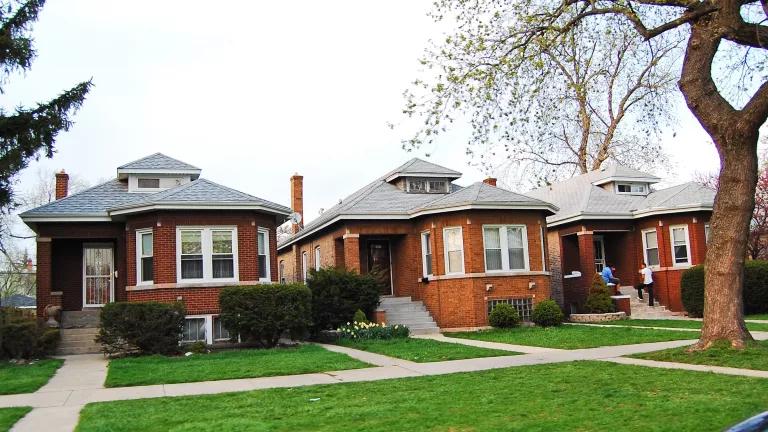New Report Finds Electric Homes Can Save Chicagoans Money
A new report finds that Chicagoans can save roughly $11,000 to $24,000 over a 20-year time period by ditching expensive gas and fully electrifying their homes.

Chicago bungalows
Co-authored by Thomas Siafa
As Chicagoans know, heating bills are through the roof. Gas bills are on the rise, and hundreds of Chicagoans are struggling to heat their homes and make ends meet. Last March, an investigation by the Chicago Sun Times found that nearly one-third of Peoples Gas customers incurred a late fee on their gas bills, and in some zip codes, nearly half of all households were behind on paying their gas bills. This winter, Chicagoans’ gas bills are expected to spike another 30 percent compared to last year.
The combustion of fossil fuels such as gas in homes to meet heating, cooking, and other household needs has proven to be harmful not only to our climate and our health but also for household energy costs. Luckily, efficient electric alternatives exist that can yield significant energy savings for the average household in Chicago. By swapping out gas-powered appliances for efficient electric appliances (like heat pumps, which are essentially highly efficient air conditioners that heat AND cool), building electrification can meet household energy needs more cost-effectively than burning expensive fossil fuels.
Electrification swaps considered in analysis

The analysis by Energy Futures Group on behalf of NRDC investigated the financial and greenhouse gas emissions reduction benefits of electrification for the average single-family and individually metered multifamily household with forced air heating in Peoples Gas territory, the gas utility that serves the city of Chicago. These two residential building types make up more than half of all residential units served by Peoples Gas and more than 60 percent of the total residential gas sold by the utility. The analysis also looked at the additional financial benefits for households eligible for the tax credits and rebates under the recently passed Inflation Reduction Act. It assessed these impacts for both new construction and existing buildings. For existing buildings, it considered both full and partial electrification, with an emphasis on investments at the time that existing gas equipment would have to be replaced.
Electrification Decision Points

A summary of the findings is presented below. Details about the analysis can be found in the report linked here.
Electrification saves households money
Our analysis finds that electrification saves households money in every scenario analyzed. This is largely due to a few factors. First, Peoples Gas prices are high. This is a function of both a dramatic increase in regional wholesale gas prices over the past couple of years and Peoples Gas’s massive spending on its pipe replacement program (a significant portion of which it recovers through variable charges on gas bills). That double whammy is expected to continue indefinitely. The combination of high Peoples Gas prices and significant efficiency advantages of electric equipment over gas equipment—a new cold-climate heat pump is nearly three times as efficient as a new gas furnace—means that gas is now significantly more expensive per unit of heat provided to a home than electricity.
Variable Single-Family Energy Costs per Unit of Heat (2022 $/Mmbtu)

Second, Peoples Gas customers who electrify their heating can move to a much lower fixed monthly gas charge—saving $25 per month. Households who fully electrify can eliminate all fixed monthly charges for gas, saving more than $50 per month. Those cost savings will be even greater in the future because Peoples Gas’s continued spending on its pipe replacement program, a significant portion of which it recovers through fixed monthly charges, is expected to drive the company’s already high fixed monthly charges even higher.
Third, households that electrify their space heating can move to ComEd’s lower electric heating rate. That doesn’t just reduce the cost of electric heat. It also reduces the cost of lighting, cooling, and all other electricity uses in a home.
Current Single-Family Utility Rates

Put simply, replacing gas appliances with efficient electric ones saves households a significant sum. This is true not only over the full 20-year period but also in the form of reduced energy bills in the first year of electrification.
Electrification helps households save big over time
The cost savings from electrification are significant, particularly in the case of new construction and full electrification of existing buildings. Cost savings over the 20-year period are projected to be upward of $15,000 for all-electric new construction and $10,000 for existing multifamily households that fully electrify. Savings are even higher for single-family homes. Full electrification yields such great cost savings because consumers avoid paying for both the cost of gas as a commodity and fixed monthly charges.
However, electrification is so cost-effective that even households that only electrify their space heating but still pay a Peoples Gas bill for hot water, cooking, and other smaller uses can expect to save at least $7,000 in multifamily apartments and nearly $9,000 in single-family homes. This is because three-quarters of gas is used for space-heating purposes in homes.
These savings are possible even without factoring in utility energy efficiency programs, which can reduce the cost of the electrification due to incentives and rebates for heats pumps, other electrification equipment, and building envelope measures, which can reduce air leakage and improve overall home efficiency.
And this is also without factoring in federal incentives.
Federal building electrification incentives generate even more cost savings
Existing households eligible for the building electrification rebates and tax credits under the Inflation Reduction Act can expect even greater financial benefits. The impact of the climate law’s incentives is greatest for low-income households—those with a household income below 80 percent of Area Median Income (AMI), which is currently about $83,350 for a family of four in Cook County, Illinois. Low-income households eligible for the climate law rebates that fully electrify can achieve an additional increase in cost savings of about $11,200 for single-family homes and $9,600 for multifamily homes!
Single Family Cost-Savings from Electrification

Multi-Family Cost-Savings from Electrification

Electrification reduces greenhouse gas emissions
If reducing energy costs wasn’t a convincing enough argument to support electrification, the analysis also finds electrification yields significant greenhouse gas (GHG) emissions reductions. In every scenario, GHG emissions over the next 20 years are at least cut in half. These overwhelmingly positive results—partly a function of the Illinois power sector’s march toward zero emissions by 2045 and partly thanks to the Climate and Equitable Jobs Act (CEJA)—would keep Chicago on pace to reach its broader climate goals and further cement Illinois as a climate leader nationally.
Single Family CO2 Emissions Reductions Across End Uses Electrified

Multi-Family CO2 Emissions Reductions Across End Uses Electrified

Next steps: Electrifying Chicago’s residential buildings
Mayor Lori Lightfoot and the city of Chicago released a report last month on achieving clean, healthy, and affordable new and existing buildings through electrification. Now it’s time for the mayor and the city to step up and make the benefits of building electrification a reality for Chicagoans. This is more urgent than ever in the face of Chicagoans’ high gas bills, the significant savings they would see from electrification, and the generous federal tax credits for people and families with low incomes.
- Chicago City Council must introduce and pass clean buildings policies that will help build the market for efficient electric appliances in new construction and provide existing buildings with sufficient funds and resources to enable electrification in underserved communities and affordable housing.
- The city of Chicago and the state of Illinois must create and implement a strategic plan for acquiring, implementing, and maximizing access to Inflation Reduction Act funds to advance building electrification in low- and moderate-income households in Chicago and other municipalities across the state.
- The state and city must coordinate with the utilities, labor unions, and existing clean buildings businesses (energy efficiency, heat pump installers, etc.) to develop worker and contractor training programs that will build a workforce ready to meet the moment of the clean buildings transition.
Starting this transition today will ensure that residents see the greatest energy savings possible and enable the creation of a more resilient, sustainable Chicago.




